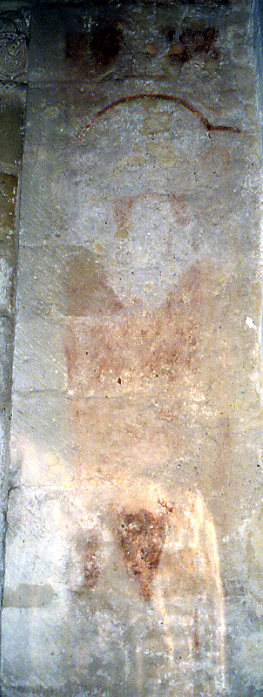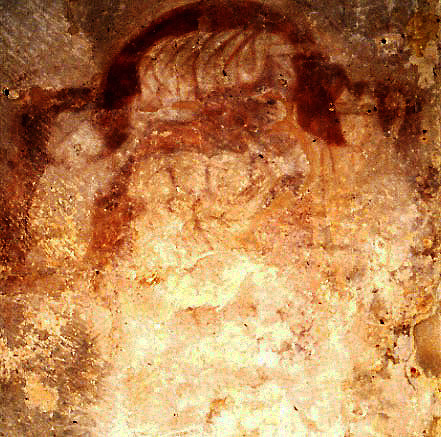Padworth, Berkshire (†) c.1225-50
St Nicholas and the Three Boys in the Barrel

There are two paintings of St Nicholas of Myra at Padworth. Both are very faint now, but in the upper painting at the south side of the chancel arch (photo, left) he stands within a rounded arch. The remains of his mitre show as vague yellow (probably implying gold) patches just below the red-painted curve of the arch, with his head and face barely visible below. His clothing is that of a bishop of his day, with the pointed lower edge of his chasuble showing as a reddish triangular shape lower down his figure. Tristram¹ could see his crozier, but this has faded into invisibility now.

But the crozier is clearer in the scene at the right, which is painted on a much smaller scale below the standing figure of Nicholas, and shows one of the more colourful legends that clustered around the the saint, a 4th century bishop of Myra (now Mugla in southern Turkey). Nicholas is the figure at the far right, his mitre and vestments clearer as he extends his right arm and hand in blessing. The three boys, set in the brine-tub by an evil butcher, are further left, the one nearest to Nicholas holding out his arm towards the saviour-saint, and half turning to look at his companions. The boys’ heads are very close together, and Tristram could see that all were wearing conical hats. In one of the most interesting circumstantial touches I have seen in a medieval English painting, their other garments are apparently draped over a rod at the top of the scene². At the far left, also in a conical hat, is a standing man with arms raised in amazement, presumably the butcher himself. Almost nothing is left of the brine-tube itself, but what must have been a similar barrel is one of the few clear details in the example of the subject remaining at Little Horwood.
The boys in the barrel incident is, in all probability, a conflation of other incidents narrated in the various versions of Nicholas’ story, where the number three recurs again and again. But the tale of the butcher and the boys was too colourfully gruesome not to pass into folklore, especially that fertile area of folklore involving lost or errant children, and it seems to have done so at an early date. The excellent St Nicholas centre website has numerous links, illustrations and versions of his story for adults and children alike. Other paintings of incidents in the life of St Nicholas are in the table below.
Website for St John the Baptist, Padworth
¹ Tristram 2, p.587
² In some versions of the story the ‘boys’ are theology students, which may account for the rather formal-looking robes and hats.